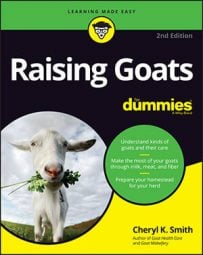Dairy goats are generally disbudded, although a minority of goat owners prefer horns because they believe it is more natural. Fiber goats are often left with horns, which are believed to help with temperature regulation, as a consideration for animals with a heavy coat. Some meat goat shows also require that the animals have horns.
Some people like the fact that you can "steer" goats by their horns. To eliminate some of the danger, they grind down the horns to remove the points (called tipping). However, tipping can cause excessive bleeding.
For those who prefer hornless goats, the ideal may be naturally hornless goats, called polled goats. The trait for polledness requires that at least one parent be hornless.
If you are concerned about or are having problems with a horned goat, try wrapping the horns with foam and duct tape, or putting polyethylene black plastic water pipe over them for padding and protection. (Don't use this method if you see other goats eating the padding, because the materials can cause a blockage in the digestive system.)
In certain goat breeds, the traits of hornlessness and hermaphroditism (having male and female sex organs) are linked. Breeding two polled goats to each other can increase the likelihood of producing a hermaphrodite.
Disbudding is best for the goat and the owner for a number of reasons:
Horned goats can get their heads stuck in fences or feeders. You may have to cut out parts of fences if you're unable to free a goat whose horns are stuck. A stuck goat is vulnerable to being butted by other goats while having no way to fight back or get away, or to dying in the hot sun if left too long.
Horned goats are more destructive. They are prone to rubbing and banging their horns on structures, fences, and feeders. A horned goat can hurt you, your guardian dog, or other goats worse than a disbudded one, particularly if the other goats don't also have horns. You may be liable if your goat injures another person with his horns.
Because horned goats are not allowed in most goat shows, are more dangerous, and are less popular among buyers, their market potential is less than that of disbudded goats.
If you want to milk a horned doe, you need a milking stand with a special head lock that horns can fit through.
Kids need to be disbudded within the first two weeks after birth, and for males, as early as two days old. Females usually do not have as much horn development as males, so earlier disbudding is not as important. Do not put off disbudding for too long, though, because doing so can make the job difficult, cause the goat unnecessary distress and pain, and result in horn regrowth or scurs.

